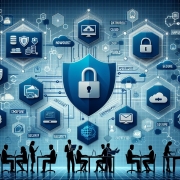


Check Point Harmony SASE and Cisco Secure Access are competing in the network security solution category. Check Point Harmony SASE is praised for its scalability and intuitive management, while Cisco Secure Access has an edge with its comprehensive feature set, favored by those prioritizing robustness.
Features: Check Point Harmony SASE provides seamless integration, flexible VPN capabilities, and enhanced remote work security. Cisco Secure Access offers advanced threat intelligence, secure access controls, and a broad array of security features, making it more extensive in terms of functionality.
Room for Improvement: Check Point Harmony SASE could improve its analytical tools and scalability for larger environments. Cisco Secure Access could benefit from simplifying its complex installation process and reducing resource consumption. Both products have distinct areas to address.
Ease of Deployment and Customer Service: Check Point Harmony SASE is recognized for its quick deployment and responsive customer support. Cisco Secure Access, with robust deployment options, faces criticism for its complex setup but benefits from knowledgeable support. The ease of deployment is notably better with Harmony.
Pricing and ROI: Check Point Harmony SASE is known for competitive pricing and cost-effective solutions, providing good ROI. Cisco Secure Access has higher setup costs but offers long-term value due to its comprehensive security features. Harmony offers immediate savings, while Cisco's extensive security infrastructure justifies its price for some users.
Clients are now comfortable and not wasting productive hours on IT support.
The automation part is giving us a cost benefit and speed; we can react faster.
It's a very useful tool to mitigate and protect your enterprise.
Check Point Harmony SASE (formerly Perimeter 81) blocked access to those URLs at the network level before users could click through.
We are saving 40% of our time, which is good.
At Amazon, we knew exactly how much it would cost if a fulfillment center was down for an hour.
From my point of view, the biggest return on investment when using Cisco Secure Access is the security it provides, and I believe the best word to describe it is best security, ensuring our protection.
There was a significant cost reduction.
They offer very accurate solutions.
The quick resolution of issues with Fortinet FortiGate is due to the support of the company and the fact that the equipment is easy to work with.
I would rate the technical support for Fortinet FortiGate a ten out of ten.
I would rate support 10 out of 10.
People working really hard, listening to every issue and request, and replying within hours.
This stems from their original business in networking, integrating router and switch operations, as well as security devices.
Although Cisco is reliable, the process to raise a support ticket has become more complex, requiring specific user accounts and access to specialized platforms.
Our engineers are very satisfied with the features, technical assistance, and documentation provided by Cisco.
They scale up really well from smaller models like the FortiGate 40 and 50 to bigger sites with the FortiGate 100 for more throughput - up to enterprise datacenters.
The variation comes in terms of the interfaces and throughputs, but from a security perspective, you get the same benefit, irrespective of whether you have an entry-level unit or an enterprise.
We determine sizing based on multiple factors: number of users, available links, traffic types, server count, services in use, and whether services will be published.
The cloud-native model ensures we are not tied to any specific location or hardware, which has been a great game changer in terms of agility.
I would rate it nine out of ten for scalability.
Check Point Harmony SASE's scalability is good; it can handle growth easily, allowing me to easily add another region and gateway to have more people join in.
We turn the traffic to the Cisco Secure Access cloud, and we can manage and apply the policies that are necessary, making it very easy to scale the solution.
I would rate scalability at eight to nine out of ten.
Cisco Secure Access scales with the growing needs of our company.
We're experiencing 99.999% availability consistently.
I would rate the stability of Fortinet FortiGate a ten out of ten.
Currently, we are experiencing a general outage of one of the main internet service providers of the Dominican Republic, and we have not been impacted in our operations because with SD-WAN, we have another internet service provider and we are working with the second WAN connection without any disruption.
There are some lags and glitches with connectivity, so I would rate the stability as between seven or eight out of ten.
After the last improvement, I can say it is much more stable now.
Check Point Harmony SASE is stable most of the time, but there are still some issues that are hard to troubleshoot.
I rate the stability of Cisco Secure Access as ten out of ten.
The solution is stable enough, and I did not experience any latency or performance issues.
I have not experienced any downtime, crashes, or performance issues.
Investing in a solution that can accommodate such growth would be more cost-effective than repeatedly purchasing new hardware.
While Fortinet claims to offer a comprehensive network solution, it falls short in addressing computer application issues, particularly server security.
When considering Sophos XG, which we also use, the logging and reporting functionality is notably more efficient.
A local data center in Turkey would enhance the product, as currently, our Internet traffic goes to another country, which is problematic for us.
One area for improvement is integration with third-party identity providers.
The product is lacking features that other competitors have, making it quite challenging to migrate customers to this solution because it feels very much unfinished.
Modernization is needed, specifically in the enhancement of security features and functionality.
Previously, sending an email would automatically create a ticket, but now it requires accessing specific portals, making the process complicated.
Prices are high when compared to competitors, which makes it challenging to position the product with customers.
Last year, I renewed the support for three years, which can sometimes be expensive but depends on the security benefits and how it helps us.
It offers cost savings as it is generally cheaper than the competition.
It is about 20% cheaper.
Cost efficiency is a consideration, as SASE products are not the cheapest security products.
The cost is a bit expensive for most users.
It is a bit expensive.
Renewal prices have been surprisingly high.
Cisco is known for being a premium product, and its pricing reflects this.
The main issue with pricing is that it is higher compared to other competitors.
In terms of security, we have not experienced any security flaws or loopholes, and it has proven to be quite stable.
FortiGate has helped reduce the risk of cyberattacks that might disrupt our client's production.
These features help reduce our downtime, manage the ISPs, and deploy SLAs for all the website traffic.
The firewall management is the most valuable feature for me.
The Zero Trust Network Access (ZTNA) feature is a major highlight as it gives users seamless and secure access to internal resources without requiring a full-blown VPN, which improves both security and user experience.
The Zero Trust and segmentation have helped my team and our customers significantly because we are able to protect every scope and allow the work-from-home users to access internal resources while passing through a threat prevention gateway, ensuring that everything is safe.
It eliminates the hassle of switching on VPNs and provides a direct connection to resources via Cisco Secure Access.
The main feature of interest to me and the customers is DNS security and Integrated Secure Web Control (ISWC).
The most valuable feature of Cisco Secure Access is the level of security it provides.



| Company Size | Count |
|---|---|
| Small Business | 350 |
| Midsize Enterprise | 130 |
| Large Enterprise | 187 |
| Company Size | Count |
|---|---|
| Small Business | 53 |
| Midsize Enterprise | 18 |
| Large Enterprise | 15 |
| Company Size | Count |
|---|---|
| Small Business | 6 |
| Large Enterprise | 7 |
Fortinet FortiGate excels in providing integrated VPN, firewalling, and Unified Threat Management (UTM) with centralized management and high availability. It supports remote access and comprehensive threat protection, making it a preferred choice for securing networks.
Fortinet FortiGate offers a robust security platform with features such as strong intrusion prevention, application control, and web filtering. Its integration with Active Directory and SD-WAN functionality provides scalable solutions for large networks. Users appreciate its ease of use through centralized management interfaces, ensuring robust security with flexible configurations. However, FortiGate could enhance its graphical interface and technical support responsiveness, address firmware bugs and costly licensing, improve logging, integrate better with third-party tools, and strengthen scalability and memory for log storage. Complexity in configuration and the need for intuitive features are noted challenges, and there's a demand for advanced security, zero-trust capabilities, and AI integration.
What are the key features of Fortinet FortiGate?Fortinet FortiGate is widely implemented across industries like education, finance, and government. Companies use it for firewall protection, VPN, and SD-WAN capabilities, ensuring secure perimeter and data center security. It facilitates remote access management and traffic routing optimization, offering reliable security and connectivity solutions.
Check Point Harmony SASE, formerly Perimeter 81, offers robust security features like split tunneling, MFA, and Zero Trust Network Access focused on secure remote access and optimized connectivity for remote teams.
Check Point Harmony SASE delivers advanced security through a user-friendly interface, efficient VPN connections, and a centralized management console. It enhances security with real-time threat intelligence from ThreatCloud and traffic management via built-in optimization. Firewall as a Service and Secure Web Gateway safeguard against unauthorized access and phishing. While users seek enhanced networking customizations and better integration with identity providers, there's an emphasis on improving reporting, real-time analytics, and policy management. Requests also include a Chrome extension, traffic balancing, and simplified configuration to address some resource-intensive aspects.
What are the key features of Check Point Harmony SASE?
How can organizations benefit from using Check Point Harmony SASE?
Check Point Harmony SASE is used across industries for secure remote access and connectivity, protecting sensitive data, and managing access to corporate resources. It is ideal for those with hybrid cloud models and requires comprehensive security measures combined with existing IT infrastructures to meet specific industry demands.
Cisco Secure Access is a comprehensive solution that ensures secure access to networks and protects against unauthorized access. It is used for network authentication, enforcing access policies, managing user identities, securing remote access, and providing secure connectivity for devices. Users have praised its robust security measures, seamless integration with existing systems, user-friendly interface, and reliable network performance.
We monitor all Secure Access Service Edge (SASE) reviews to prevent fraudulent reviews and keep review quality high. We do not post reviews by company employees or direct competitors. We validate each review for authenticity via cross-reference with LinkedIn, and personal follow-up with the reviewer when necessary.